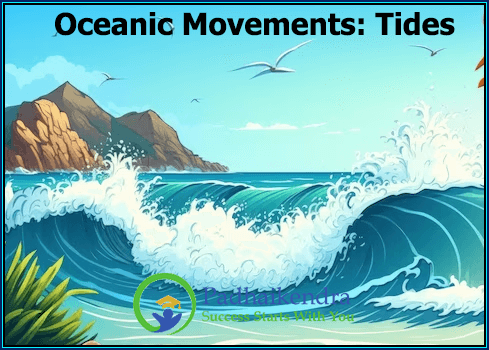Tides are the rise and fall of sea level caused by the gravitational pull of the moon and the sun. The gravitational pull of these celestial bodies creates a bulge of water on the side of the Earth that is closest to them, as well as a bulge on the opposite side of the Earth. These bulges create a tidal cycle that occurs twice a day and is most pronounced in areas with narrow or shallow waterways, such as bays, estuaries, and harbors.
Tides can have a significant impact on navigation, fishing, and other activities that rely on the movement of water. They can also have an ecological impact, as they can affect the distribution of nutrients and other substances that are important for marine life. Understanding the characteristics and behavior of tides is important for managing coastal resources and protecting human lives and property.
Causes of tides
Tides are caused by the gravitational forces of the moon and the sun on the Earth’s oceans. The gravitational pull of the moon is the primary force that causes tides, while the gravitational pull of the sun also contributes to the tides, although to a lesser extent. The gravitational attraction of these celestial bodies creates a bulge of water on the side of the Earth that is closest to them, as well as a bulge on the opposite side of the Earth. These bulges create a tidal cycle that occurs twice a day and is most pronounced in areas with narrow or shallow waterways, such as bays, estuaries, and harbors.
The intensity of the tides can be affected by various factors such as the alignment of the Earth, moon, and sun, the distance between them, the shape of the coastline, and the depth and width of the ocean basin. The position of the Earth and moon relative to the sun changes over the course of a month, resulting in changes in the strength of the gravitational pull on the Earth’s oceans and therefore changes in the intensity of the tides.
Overall, the causes of tides are complex and involve the interaction of various factors such as gravitational forces, ocean basin shape, and coastline features. Understanding the causes of tides is important for managing coastal resources and protecting human lives and property.
Features of tides
Tides have several features, including:
- Periodicity: Tides occur in a regular cycle, with two high tides and two low tides occurring approximately every 24 hours and 50 minutes.
- Amplitude: The amplitude of tides refers to the difference in height between high and low tides. The amplitude of tides can vary depending on the location, with some areas experiencing large tides while others experience small tides.
- Range: The range of tides refers to the difference in height between the highest high tide and the lowest low tide over a particular period of time, such as a month or a year.
- Spring and neap tides: Spring tides occur when the gravitational forces of the moon and the sun reinforce each other, resulting in higher-than-normal tides. Neap tides occur when the gravitational forces of the moon and the sun are at right angles to each other, resulting in lower-than-normal tides.
- Currents: Tides can create strong currents as the water moves in and out with the rising and falling tides.
- Flood and ebb: Flood tide is the incoming tide as the water level rises, while ebb tide is the outgoing tide as the water level falls.
Understanding the features of tides is important for managing coastal resources, navigation, and other activities that rely on the movement of water.
Types of Tides
There are several types of tides, including:
- Diurnal tides: Diurnal tides occur when there is only one high tide and one low tide each day. These tides are most common in the tropics.
- Semidiurnal tides: Semidiurnal tides occur when there are two high tides and two low tides each day, with approximately the same height. These tides are most common in areas with a moderate climate.
- Mixed tides: Mixed tides occur when there are two high tides and two low tides each day, but the height of the tides varies significantly. These tides are most common in areas with a large tidal range.
- Spring tides: Spring tides occur when the gravitational forces of the moon and the sun reinforce each other, resulting in higher-than-normal tides. These tides occur twice a month, during the new and full moons.
- Neap tides: Neap tides occur when the gravitational forces of the moon and the sun are at right angles to each other, resulting in lower-than-normal tides. These tides occur twice a month, during the first and third quarters of the moon.
The type of tide that occurs in a particular location depends on a variety of factors, such as the shape of the coastline, the depth of the water, and the position of the moon and sun relative to the Earth. Understanding the type of tide that occurs in a particular location is important for managing coastal resources, navigation, and other activities that rely on the movement of water.





